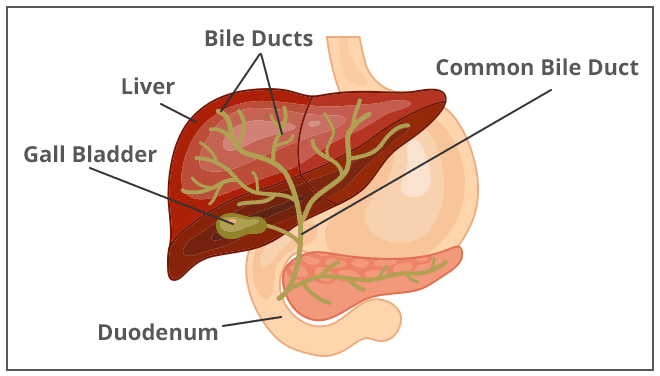Definition & Facts for Alagille Syndrome
In this section:
- What is Alagille syndrome?
- How common is Alagille syndrome?
- Who is more likely to have Alagille syndrome?
- What are the complications of Alagille syndrome?
What is Alagille syndrome?
Alagille syndrome is a genetic disorder that may affect many different parts of the body, including the liver, heart, eyes, face, skeleton, blood vessels, and kidneys.
A person with Alagille syndrome has fewer than the normal number of small bile ducts inside the liver. Bile ducts carry bile from the liver to the gallbladder for storage and then to the first part of the small intestine, also called the duodenum, for use in digestion. With fewer small bile ducts, less bile flows out of the liver. This condition is called cholestasis. As bile builds up in the liver, it may cause liver damage.
 Bile ducts are tubes that carry bile from the liver to the gallbladder and the duodenum.
Bile ducts are tubes that carry bile from the liver to the gallbladder and the duodenum.
How common is Alagille syndrome?
About 1 in every 30,000 babies is born with Alagille syndrome.1
Who is more likely to have Alagille syndrome?
The gene mutation that causes Alagille syndrome can be passed from parent to child. Children who have one parent with Alagille syndrome have a 50 percent chance of inheriting the gene and having the disease.2
However, at least half—50 to 70 percent—of people with Alagille syndrome do not have a parent with the disease.3 In these cases, the disease is caused by a new gene mutation that is not inherited from a parent.
The liver signs and symptoms of Alagille syndrome usually appear shortly after birth or in early infancy. For this reason, Alagille syndrome is often diagnosed in children younger than age 1.4
What are the complications of Alagille syndrome?
Alagille syndrome can lead to complications that affect the liver and other parts of the body. Alagille syndrome varies greatly from person to person. In different people, the disease may affect different organs. The disease may also affect organs more seriously in some people than in others. Many people with Alagille syndrome have only mild symptoms and can lead normal lives with normal life expectancy. However, others have severe and even life-threatening complications such as liver failure, serious heart defects, and bleeding or stroke due to blood vessel problems.
Liver complications
In Alagille syndrome, less bile flows out of the liver, and the buildup of bile in the liver may cause liver damage.
Some young children with Alagille syndrome have a severe buildup of bile in the liver. In about half of these children, the flow of bile out of the liver improves by age 5. In the other half, the buildup of bile in the liver gets worse and leads to complications.5
Liver complications of Alagille syndrome may include
- cirrhosis, in which scar tissue replaces healthy liver tissue and prevents the liver from working normally. As cirrhosis gets worse, the liver begins to fail.
- portal hypertension, which occurs when scar tissue partly blocks the flow of blood through the liver, increasing pressure in the portal vein.
- liver failure, a condition in which the liver is badly damaged and stops working. Liver failure may require a liver transplant.
- liver cancer. Alagille syndrome increases the risk for liver cancer.
Other complications
Alagille syndrome may cause complications in other parts of the body, such as
- serious heart defects, such as tetralogy of Fallot, which require treatment with surgery
- narrowing and weakness in the blood vessels in the brain that may lead to bleeding and stroke
- problems with growth, delayed puberty, or failure to thrive
- bone problems, such as osteoporosis or frequent broken bones
References
This content is provided as a service of the National Institute of Diabetes and Digestive and Kidney Diseases
(NIDDK), part of the National Institutes of Health. NIDDK translates and disseminates research findings to increase knowledge and understanding about health and disease among patients, health professionals, and the public. Content produced by NIDDK is carefully reviewed by NIDDK scientists and other experts.

